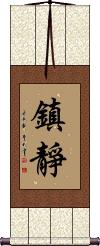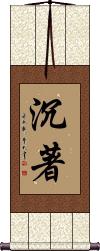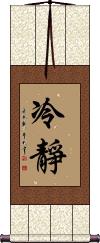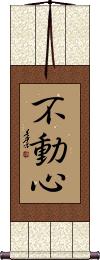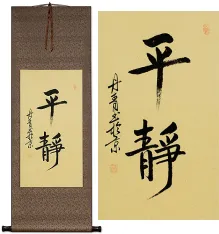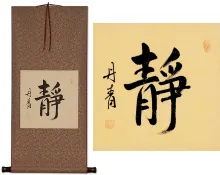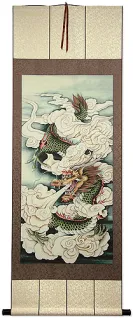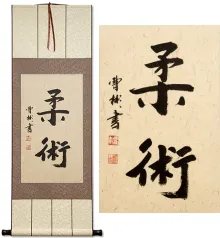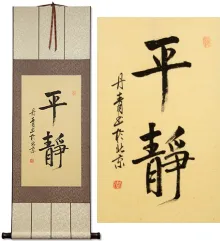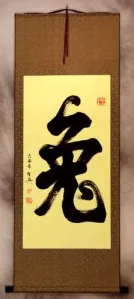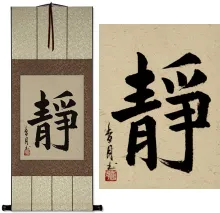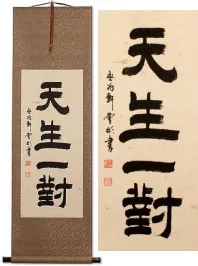Many custom options...
And formats...

Calm Cool in Chinese / Japanese...
Buy a Calm Cool calligraphy wall scroll here!
Personalize your custom “Calm Cool” project by clicking the button next to your favorite “Calm Cool” title below...
Calm / Cool
鎮靜 represents the idea of being calm, cool, or relaxed in Chinese, Japanese Kanji, and old Korean Hanja.
My Korean dictionary further defines this as quiet, calm, tranquility, and pacification.
From my Japanese dictionary: calm, quiet, tranquility, appeasement, pacification.
Note: This term is also used in Korean Hanja but there is a slight deviation in the way they write the second character in Korean. Still, a Korean person who can read Hanja, will be able to read this word. We can write it in the Korean form if you wish (just let us know when you place your order). In Korean, this is the word you might use to tell someone to "calm down" or "take it easy."
Calm and Collected
Calm / Cool-Headed
冷靜 means calm and cool-headed in Chinese, Japanese, and Korean.
Other translations: calmness, composure, coolness, serenity, tranquility.
冷靜 is a good wall scroll for someone that wants to remind themselves to stay calm and level-headed.
See Also: Sober Calm
Presence of Mind
Immovable Mind
fudoshin
不動心 is one of the five spirits of the warrior (budo) and is often used as a Japanese martial arts tenet.
Under that context, places such as the Budo Dojo define it this way: An unshakable mind and an immovable spirit is the state of fudoshin. It is courage and stability displayed both mentally and physically. Rather than indicating rigidity and inflexibility, fudoshin describes a condition that is not easily upset by internal thoughts or external forces. It is capable of receiving a strong attack while retaining composure and balance. It receives and yields lightly, grounds to the earth, and reflects aggression back to the source.
Other translations of this title include imperturbability, steadfastness, keeping a cool head in an emergency, or keeping one's calm (during a fight).
The first two Kanji alone mean immobility, firmness, fixed, steadfastness, motionless, and idle.
The last Kanji means heart, mind, soul, or essence.
Together, these three Kanji create a title defined as “immovable mind” within the context of Japanese martial arts. However, in Chinese, it would mean “motionless heart,” and in Korean Hanja, “wafting heart” or “floating heart.”
This in-stock artwork might be what you are looking for, and ships right away...
Gallery Price: $79.00
Your Price: $43.88
Gallery Price: $72.00
Your Price: $39.88
Gallery Price: $200.00
Your Price: $92.88
Gallery Price: $103.00
Your Price: $56.88
Gallery Price: $79.00
Your Price: $43.88
Gallery Price: $200.00
Your Price: $109.88
Gallery Price: $200.00
Your Price: $90.88
Gallery Price: $79.00
Your Price: $43.88
Gallery Price: $198.00
Your Price: $109.88
Not the results for Calm Cool that you were looking for?
Below are some entries from our dictionary that may match your Calm Cool search...
| Characters If shown, 2nd row is Simp. Chinese |
Pronunciation Romanization |
Simple Dictionary Definition |
冷靜 冷静 see styles |
lěng jìng leng3 jing4 leng ching |
More info & calligraphy: Calm / Cool-HeadedSee: 冷静 |
鎮靜 镇静 see styles |
zhèn jìng zhen4 jing4 chen ching |
More info & calligraphy: Calm / Cool |
不動心 see styles |
fudoushin / fudoshin ふどうしん |
More info & calligraphy: Immovable Mind |
泰然自若 see styles |
tài rán zì ruò tai4 ran2 zi4 ruo4 t`ai jan tzu jo tai jan tzu jo taizenjijaku たいぜんじじゃく |
More info & calligraphy: Presence of Mind(adj-t,adv-to) (yoji) having presence of mind; self-possessed; imperturbable; calm and self-possessed |
恬 see styles |
tián tian2 t`ien tien yasushi やすし |
quiet; calm; tranquil; peaceful (adj-t,adv-to) (obsolete) (See 恬として) cool; indifferent; nonchalant; calm; (given name) Yasushi |
鎮 镇 see styles |
zhèn zhen4 chen yasushi やすし |
to press down; to calm; to subdue; to suppress; to guard; garrison; small town; to cool or chill (food or drinks) (1) (archaism) {Buddh} a weight; (2) (ちん only) temple supervisor; (3) (ちん only) town (of China); (personal name) Yasushi |
冷す see styles |
hiyasu ひやす |
(transitive verb) (1) to cool (from room temperature); to chill; to refrigerate; (2) to calm down; to cool off; to regain one's composure; to relax; (3) to be frightened (at); to be scared (of) |
尸羅 尸罗 see styles |
shī luó shi1 luo2 shih lo shira |
sila (Buddhism) Sila, 尸; 尸怛羅 intp. by 淸凉 pure and cool, i.e. chaste; also by 戒 restraint, or keeping the commandments; also by 性善 of good disposition. It is the second pāramitā, moral purity, i. e. of thought, word, and deed. The four conditions of śīla are chaste, calm, quiet, extinguished, i. e. no longer perturbed by the passions. Also, perhaps śīla, a stone, i. e. a precious stone, pearl, or coral. For the ten śīlas or commandments v. 十戒, the first five, or pañca-śīla 五戒, are for all Buddhists. |
平気 see styles |
heiki / heki へいき |
(noun or adjectival noun) (1) cool; calm; composed; unconcerned; nonchalant; unmoved; indifferent; (adjectival noun) (2) (colloquialism) all right; fine; OK; okay |
平然 see styles |
heizen / hezen へいぜん |
(adj-t,adv-to) calm; composed; cool; quiet |
恬然 see styles |
tián rán tian2 ran2 t`ien jan tien jan tenzen てんぜん |
unperturbed; nonchalant (adj-t,adv-to) (form) cool; indifferent; nonchalant; calm |
鎮定 镇定 see styles |
zhèn dìng zhen4 ding4 chen ting chintei / chinte ちんてい |
calm; unperturbed; cool (n,vs,vt,vi) (hist) suppression (e.g. of a rebellion); pacification |
冷やす see styles |
hiyasu ひやす |
(transitive verb) (1) to cool (from room temperature); to chill; to refrigerate; (2) to calm down; to cool off; to regain one's composure; to relax; (3) to be frightened (at); to be scared (of) |
沉住氣 沉住气 see styles |
chén zhù qì chen2 zhu4 qi4 ch`en chu ch`i chen chu chi |
to keep cool; to stay calm |
治まる see styles |
osamaru おさまる |
(v5r,vi) (1) to die down (storm, anger, conflict, etc.); to calm down; to cool off; to abate; to be settled; to be brought under control; (v5r,vi) (2) to be at peace; to be governed well; (v5r,vi) (3) to subside (of pain, symptoms, etc.); to be alleviated; to get better; to ease off |
冷静沈着 see styles |
reiseichinchaku / resechinchaku れいせいちんちゃく |
(noun or adjectival noun) (yoji) calm, cool, and collected; level and calm |
沈着冷静 see styles |
chinchakureisei / chinchakurese ちんちゃくれいせい |
(noun or adjectival noun) (yoji) calm, cool, and collected; level and calm |
沉不住氣 沉不住气 see styles |
chén bù zhù qì chen2 bu4 zhu4 qi4 ch`en pu chu ch`i chen pu chu chi |
to lose one's cool; to get impatient; unable to remain calm |
心靜自然涼 心静自然凉 see styles |
xīn jìng zì rán liáng xin1 jing4 zi4 ran2 liang2 hsin ching tzu jan liang |
a calm heart keeps you cool (idiom) |
落ちついた see styles |
ochitsuita おちついた |
(can act as adjective) (1) calm; composed; cool; (2) settled; fixed; established; (3) unobtrusive; quiet; subdued; low-key (color) |
落ち着いた see styles |
ochitsuita おちついた |
(can act as adjective) (1) calm; composed; cool; (2) settled; fixed; established; (3) unobtrusive; quiet; subdued; low-key (color) |
落ち着き払う see styles |
ochitsukiharau おちつきはらう |
(v5u,vi) to stay calm; to keep cool |
Variations: |
hiyasu ひやす |
(transitive verb) (1) to cool; to chill; to refrigerate; (transitive verb) (2) to calm down; to cool off; to regain one's composure; to relax; (transitive verb) (3) to be frightened (at); to be scared (of) |
Variations: |
hiyayaka ひややか |
(adjectival noun) (1) cold; chilly; cool; (adjectival noun) (2) cold (attitude, stare, etc.); frigid; indifferent; distant; surly; curt; (adjectival noun) (3) composed; cool; calm |
Variations: |
suzushige すずしげ |
(adjectival noun) (1) (See 涼しい・1) cool (of temperature); refreshing; (adjectival noun) (2) (See 涼しい・2) clear (of sound, objects, etc.); bright; (adjectival noun) (3) (See 涼しい・4) composed; calm (demeanour); cool; unruffled |
Variations: |
ochitsuita おちついた |
(can act as adjective) (1) calm; composed; cool; (can act as adjective) (2) settled; fixed; established; (can act as adjective) (3) unobtrusive; quiet; subdued; low-key (color) |
The following table may be helpful for those studying Chinese or Japanese...
| Title | Characters | Romaji (Romanized Japanese) | Various forms of Romanized Chinese | |
| Calm Cool | 鎮靜 镇静 | chin sei / chinsei | zhèn jìng zhen4 jing4 zhen jing zhenjing | chen ching chenching |
| Calm and Collected | 沉著 沉着 | chén zhuó chen2 zhuo2 chen zhuo chenzhuo | ch`en cho chencho chen cho |
|
| Calm Cool-Headed | 冷靜 冷静 | rei sei / reisei | lěng jìng leng3 jing4 leng jing lengjing | leng ching lengching |
| Presence of Mind | 泰然自若 | taizenjijaku | tài rán zì ruò tai4 ran2 zi4 ruo4 tai ran zi ruo tairanziruo | t`ai jan tzu jo taijantzujo tai jan tzu jo |
| Immovable Mind | 不動心 | fu dou shin fudoushin fu do shin | ||
| In some entries above you will see that characters have different versions above and below a line. In these cases, the characters above the line are Traditional Chinese, while the ones below are Simplified Chinese. | ||||
Successful Chinese Character and Japanese Kanji calligraphy searches within the last few hours...
